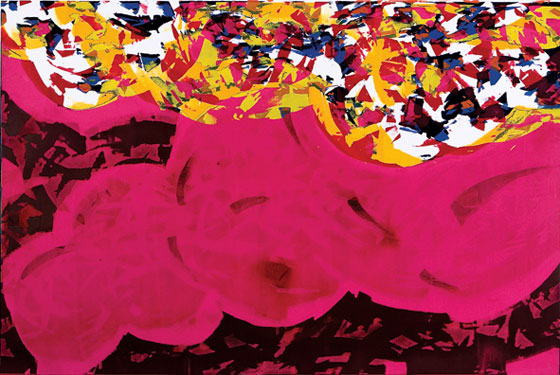|
|
| An incomprehensible feeling of distance: Jānis Murovskis Iliana Veinberga, Art Critic Jānis Murovskis. New Works 14.09.– 25.10.2010. Latvian Academy of Sciences | |
 Jānis Murovskis. A mole's mound. Silk-screen. 102x72 cm. 2009. Photo: Jānis Murovskis | |
| This event is intriguing due to a number of aspects. Firstly and mainly because these various aspects worthy of attention are embodied in a fairly small exhibition set up away from the epicentres of culture, and without particular need and knowledge could easily slip by unnoticed. For example, the fact that an art exhibition is taking place at the Latvian Academy of Sciences – on the one hand, that’s a good reason for those interested to break away from their daily routine and come to a location, an outstanding Stalinist architectural monument, where otherwise they wouldn’t have done without special reason (for many this may have meant never in their entire life). On the other hand – for the residents of the Academy of Sciences, who are mostly used to formal expositions of the exact sciences, it is good training for the acceptance of creative expression in other formats. The display on the 2nd floor is not large – just nine graphic art works from 2009 and 2010, done in silk-screening technique, which neatly fit in and decorate the official-looking foyer outside the Senate Meeting Hall and other offices of management. But the very harmonious arrangement does not allow one to ignore these works, and in focussing on them, an equally harmonious world is revealed. The primary source of inspiration, it seems, has been Japanese culture. Mount Fuji is featured, there is the flowering of the Sakura and the Tokyo hurly-burly of colour. As if central and well-known tourist spots, even for those who haven’t been in Japan, these popular characteristic elements have been captured with true emotionality, in a boldly trusting openness. For example, the artist conveys the overfull feeling of blossoming cherry by portraying the contrasts, the delicate flowers, their incomprehensible abundance which burgeons into a “madness of flowering” and visual contrast with the “black starlings, which hop between the flowers along the black stumps”. Of course, none of these images is directly brought to life in the artwork, the image being partly abstract, because the main elements are colour and rhythm, which is sufficient to create the required feeling. In terms of form the works are fascinating! | |
 Jānis Murovskis. Crematorium. Silk-screen. 102x72. 2009. Photo: Jānis Murovskis | |
| Tokyo’s medley and confusion of colour in the rain becomes so out-of-control for the eyes that “a protective reaction occurs – everything seems black and white”. And further the artist adds: “I want to speak to someone. I want to go home.” There – this is the second aspect which is so appealing in Jānis Murovskis’ silk-screens: a simple dose of human emotionality. In the exhibition it appears superbly in the works where the theme is unmistakably Latvian landscape, Latvian culture and the realm of everyday experience interwoven with Japanese experiences: Kurmja rakums [‘A mole’s mound’], in which it’s asserted that every country farmstead has its own Mount Fuji, and a vision of mountain tops with a ring of clouds in Vasarā [‘In summer’], in which “no Sarkandaugavas staltajiem skursteņiem sīvu sēru sviež, no Cēsu puses negaiss nāk” [“[from] Sarkandaugava’s stately chimneys a pungent sulphur is flung, a thunderstorm approaches from Cēsis”]. Why do I wish to emphasize this human emotionality specifically? Ignoring not only the excellent graphic art works, but also the works in which mixed techniques flow over defined material boundaries into a conceptual and spatial world, Murovskis – unlike others of his contemporaries – is not the focus of popular attention. The reason for this could be that the medium of graphic art is subordinated to other “more valuable” media in the local hierarchy. Perhaps such things as emotions, sensuality, enthusiasm, the intimate contemplation of personal experience and decorativeness is reserved for women and for children’s books, while the common quality among the men (and often also women) in focus is ideas that transcend prosaic materiality, “neutral” concepts estranged from direct experience, or even unconcealed aggression. Murovskis’ art isn’t like that, it is too “warm”, and the lively presence of the author is far too tangible. | |
 Jānis Murovskis. Tokyo rain. Silk-screen. 102x72 cm. 2009. Photo: Jānis Murovskis | |
| Perhaps Latvia doesn’t have powerful theoreticians – or any theoreticians at all – who could shape and work with the discourses which would become dominant in the local cultural space. However, that doesn’t mean that the creation and evaluation of art facts takes place somehow spontaneously; there are probably rules, but they are to a great degree intuitive, namely, everyone knows what happens and why, but can’t communicate this because understanding is based on education, experience and bits of information gathered over time, and not in some learnt tradition. Here it would be appropriate to ask the question – how then is this Latvian “intuitive discourse, unspoken in words” shown off? This is not the place to offer an answer, merely an interim observation that within the framework of this discourse an unmotivated and perhaps even unwitting self-censorship is taking place, and as a result many fascinating and fecund things remain outside the range of attention, causing Latvia’s cultural landscape to appear somewhat homogeneous. /Translated into English: Uldis Brūns/ | |
| go back | |







